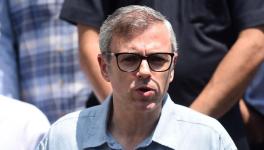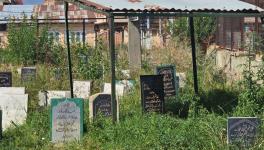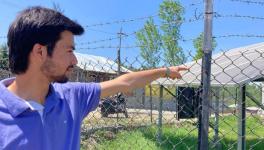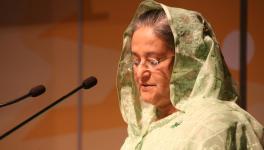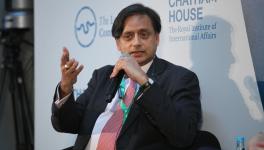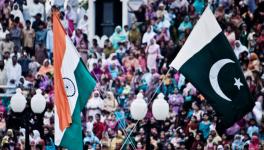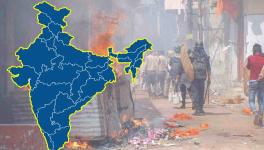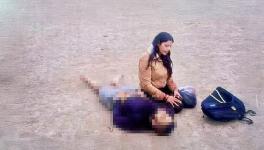Across LoC, an Electoral Annihilation of Regional Forces
Representational use only. Image Source: The Print
While yielding expected results in favour of Imran Khan’s Tehreek-e-Insaf (PTI), the electoral exercise that took place on 25 July in the mountainous Pakistan-administered Jammu and Kashmir (PAJK) points to a near-about electoral annihilation of regional political forces. There is a separate Constitution for PAJK; the chief executive is called the Prime Minister and the constitutional head is the President. The big elephant in the room is the institutional control of Islamabad.
PAJK, a western slice of the former princely state touching both Pir Panjal mountains and lower Himalayas with a population of over four million, has often been in international headlines for the wrong reasons. In October 2005, the region was the epicentre of a devastating earthquake. The region also had the infamous distinction of being associated with terrorist organizations that have attacked global cities. In his interrogation, Ajmal Amir Kasab, one of the ten terrorists on a shooting spree in Mumbai in November 2008, had reportedly said that he was trained in Muzaffarabad, the capital of the region. Muzaffarabad is adjacent to Abbottabad, where Osama Bin Laden was killed by the US Navy seals on 2 May 2011. The attackers of the London Tube attack on 7 July 2005 had trained in the region.
In this connection, the 2021 elections gave a rare opportunity for the region to be in the public domain beyond the security lens. Out of fifty-three seats, forty-five are general seats that went to the polls in the 2021 election to the region. PTI won twenty-six seats whereas the Pakistan Peoples Party (PPP) came in second with eleven seats while the Pakistan Muslim League-Nawaz (PML-N) won six seats. A closer examination of the results points to new political trajectories for PAJK though there is no complete divorce from the past.
First, due to huge financial dependence over Islamabad as one-fourth of the budget comes from the federal government, there is a perception that the ruling party in Muzaffarabad should be on the right side of the party in power in Islamabad. So the victory of the PTI was not unexpected. However, previously, the leaders of local regional parties such as the Muslim Conference (MC) acted as proxies to enunciate the Pakistani state’s position on the Kashmir issue to an international audience. The MC was founded in 1932 by Jammu-born Ghulam Abbas (b. 1904) and Srinagar-born Sheikh Abdullah (b. 1905). Later on, the two jointly converted MC into the National Conference. After differences between the two, Abbas revived the MC and with the de-facto bifurcation of J&K in 1947, during communal riots on both sides of Line of Control, he migrated from the Jammu plains to adjoining Pakistani Punjab.
The 1949 Karachi agreement, which provides the first constitutional relationship between PAJK and Pakistan, had institutionalised the role of the MC. In the political system that existed from 1947 to 1960, the person at the helm of the MC was nominated the president of the region. The Pakistani government decided on the MC leadership. For instance, Ibrahim Khan, who hailed from a landlord family of the hilly Poonch area of Jammu, was dislodged from power to make way for Jammu plains migrant Chowdhary Ghulam Abbas in May 1950. Amidst differences between Abbas and Ibrahim Khan, the Pakistani state supported the former due to Abbas’s close long-standing association with the top leadership of the ruling Muslim League. Since most of the migrants settled in Pakistani Punjab province, Abbas had a large following there.
Though there were several intermittent institutional changes the MC leadership remained the principal political force of PAJK. Only in 1988, when Benazir Bhutto was sworn in as prime minister an elected government of Bhutto’s Pakistan People’s Party in the region was installed. In the years to follow, the MC electorally competed with mainstream Pakistani parties but it retained its importance because of its association with the region. However, in the 2021 election, the MC has now nearly faded into oblivion as its leader and former prime minister Sardar Attique Ahmed Khan won a solitary seat for the party.
Second, even though the region has become an extension of Pakistani politics, the region’s power structure based on caste is being reflected in the post-election phase. The internal tug of war is between the Jats in the southern part of the Mirpuri-Kotli belt, a community that is present in the UK in large numbers, and various powerful clans in the central part of Bagh and Haveli, one of the prime catchment areas of the Pakistani army. The British army recruited men from the central part of the region in large numbers, sending many of them to the far-off shores of Europe during the two World Wars. The army as a career continued to be attractive even after 1947, only this time, the Pakistani army was the one recruiting them. Because of the association with the Pakistani army, the country’s most important institution, the Sudhans, Rajputs, Mughals and other caste groups from the region’s central pocket had initially dominated the political and social life of the region.
After the 1960s, because of large-scale migration to the UK from Mirpur and consequent remittances, rival elite social structures in the region were created. In the 1980s, over 50% of Pakistan’s foreign exchange earnings reportedly came from the Mirpur diaspora living in Birmingham followed by Bradford cities of the UK. Some British nationals, who were born in Mirpur, claim that more than half of the population living in Britain on Pakistani passports originated in Mirpur. Mirpur is to the southern part of the region, adjoining the Gujarat area of Pakistani Punjab and the Jats are the dominant group here. In 1996, Barrister Sultan Mehmood Chaudhry, a Mirpuri Jat, was elected the prime minister on the Pakistan People’s Party (PPP) ticket, which energised the diaspora. This was the first time a Jat became the prime minister or executive head of the region.
The post-election contest for the post of Prime Minister within PTI reflected this power struggle between the two groups. The context is between Sardar Tanveer Ilyas, a rich financier to PTI from influential Maldyal caste group in Bagh area, a community which has a strong presence in Pakistani army, and former Prime Minister of the region, Barrister Sultan Mahmood, a Jat from Mirpur who is popular in the southern part of the region and diaspora circles. However, the PTI finally decided upon Sardar Abdul Qayum Niazi, belonging to Rajput caste group from the central part of the region, as the PM candidate of the region. Niazi, who had left the Muslim Conference two-years ago to join the PTI, is from Abbaspur area which is located close to Line of Control.
Three, like previous occasions, the electoral process for the twelve refugees constituencies out of forty-five elected seats abetted allegations of foul play. These seats are reserved for the people who migrated from the Indian side of Jammu and Kashmir in 1947 and settled down in various parts of Pakistan. Nine of these seats are located in different parts of the Punjab while the remaining constituencies are scattered in Khyber Pakhtunkhwa, Balochistan and Sindh. Equal seats—six each—have been allocated for refugees coming from Kashmir province and Jammu province respectively, the two culturally, ethnically and linguistically distinct provincial units. However, on the ground, it results in absurdity in terms of representation as minimal migration took place from Kashmir valley. Reportedly, in the 2021 election, 3,73,652 were registered in the six constituencies representing the refugees from Jammu whereas 29,804 were registered in the six constituencies representing the refugees from Kashmir Valley. That means registered voters with roots in Kashmir valley are only seven per cent of those registered from Jammu province.
In 2021, nine out of these twelve seats were won by the PTI. In these seats, dispersed across Pakistan, the victory margins were expectedly razor-thin. In one of the publicised incidents, the PML-N candidate from LA-35 Jammu-2, a constituency formed by clubbing some areas of Gujranwala, Sialkot and Hafizabad districts in Pakistani Punjab, Choudhary Muhammad Ismail Gujjar, alleged that “the deputy commissioner had allegedly kicked out PML-N and All Jammu and Kashmir Muslim Conference's polling agents.” In anger, he said he would “seek India's help” if the local administration did not cooperate with him.
The PTI in refugee seats won seventy-five per cent of the seats whereas it won forty-eight per cent of the seats in the remaining thirty-three elected seats within the region. In fact, the present regional chief of PTI, who is one of the top contenders for the post of Prime Minister, Sultan Mehmood Chaudhry had in December 2007 had demanded that the twelve seats of the PAJK legislative assembly reserved for “Kashmiris” settled in other areas of Pakistan be abolished, alleging that “the ruling parties in Pakistan always manipulate elections for these seats and help install governments of their own choice in the region.”
Four, the region is entirely a Pahari or Pothwari speaking belt, which is akin to the Punjabi language. Still, the term “Kashmiris” was quite often invoked by many to self-identify. This can be attributed to other factors as well, including class, as with greater wealth the locals, particularly in the south, want to distinguish themselves from their fellow caste-members living in adjoining areas of Punjab province. There is also a lack of state support to local cultural identity markers like the Pahari language though the diaspora has taken several initiatives in this regard. Within the diaspora and many sections of the society in the region with exposure to western secular institutions, there is also an attachment to the romantic idea of secular and independent J&K rather than religious centric Pakistani identity. They are termed by the Pakistani state and mainstream media as “nationalist forces”. To hold these views, many leaders from the “nationalist forces” such as Late Abdul Khaliq Ansari from Mirpur were imprisoned for long years by the Pakistani state for demanding a “united and independent J&K” as it existed before 1947 and thus rejecting the Pakistani state-supported idea of a merger of J&K with Pakistan.
Because of his stay in the UK and familiarity with the views of diaspora, PM Khan, while campaigning in the region, repeatedly stated that after “the UN mandated referendum, his government will hold another referendum, where the people of Kashmir will be given the choice to either live with Pakistan or become an independent state.” This caused a stir within the mainstream Pakistani media and politicians who alleged that Pakistani PM Khan had diluted the traditional stance of Pakistan towards J&K which was based on its merger with Pakistan. Khan’s supporters pointed out that he did not say anything new as Article 257 of the Pakistan Constitution says more or less the same thing. Article 257 states, “When the people of the State of Jammu and Kashmir decide to accede to Pakistan, the relationship between Pakistan and the State shall be determined in accordance with the wishes of the people of that State.”
To sum up, the 2021 elections were marked by near-about electoral annihilation of the Muslim Conference, a political legatee of regional politics, amplification of power struggle between the caste groups, the charges of foul play in favour of the PTI, particularly in the context of refugee seats and continuing dissonance between the linguistic and political identity of the region. With these developments, it will be important to keep an objective focus on the post-election regional granularities as many of the complex threads of the subcontinent’s peace and security issues depend on it.
The writer is the author of ‘Across the LoC’, published by Columbia University Press. The views are personal.
Get the latest reports & analysis with people's perspective on Protests, movements & deep analytical videos, discussions of the current affairs in your Telegram app. Subscribe to NewsClick's Telegram channel & get Real-Time updates on stories, as they get published on our website.









